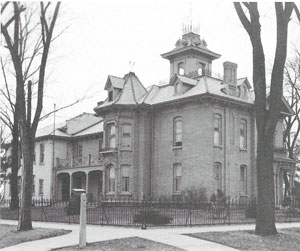Sisters dedicate St. Savior’s Hospital in Portage, Wis. (now Divine Savior Healthcare)
Before expanding their hospital care in Wisconsin, Salvatorian Sisters primarily worked at St. Mary’s in Columbus, Wis. and St. Mary’s in Wausau. In 1916, Mrs. Alois Zienert of Portage, Wis. fell ill and could not find suitable care in her city. At the time, the city of Portage was served by two physicians at two small hospitals. Faced with the options of traveling to Chicago or nearby Columbus for surgery, she chose the latter for its reputation and proximity. Both Mrs. Zienert and her husband were impressed by the care she received. With their friends and neighbors in mind, the Zienerts approached the Salvatorian Sisters at St. Mary’s and asked them to expand their care to Portage.
Although at first hesitant, the sisters eventually became very enthusiastic about opening a hospital in Portage. They build the hospital on donated land on the banks of the Wisconsin River and named it St. Savior’s Hospital. Over the next 11 years the hospital underwent three additions, including a chapel.

Through their years of friendship with the Zienerts, the sisters continually prayed that Mr. Zienert, a nonpracticing Catholic, would return to the Church. In 1922, Mr. and Mrs. Zienert died in an automobile accident. Mr. Zienert lived for two days after the crash, during which time he received the sacraments and expressed his trust in God. Zienert Mansion was left to the Salvatorian Sisters and converted into a home for elderly women known as St. Savior’s Annex.
In 1954, St. Savior’s Hospital became Divine Savior Hospital, and years later, renamed Divine Savior Healthcare. In 2017, Sisters of the Divine Savior celebrated 100 years of service and sponsorship.
Just a month before the sisters dedicated St. Savior’s Hospital, the U.S. declared war on Germany and began sending soldiers, doctor and nurses overseas. The war affected everyone. Anti-German sentiment was freely expressed in public and all German-born immigrants in the U.S. – including Salvatorians – had to register with the government. Salvatorians in America anxiously awaited news from Europe and much of what they heard was not good. By 1918, there was little peace – even in people’s hearts.
This 1918 entry in the sisters’ Chronicles from Wausau ends on a humorous note, but leaves no doubt that German-born immigrants were unsure of themselves as American citizens and living on edge at that time.
Since the Sisters were at supper, the doors had been conscientiously locked. But as a good house mother, Sister Concordia (Frank) went back to see if everything was in order. She then saw the case which the express man had brought. She picked up the box and on her way she heard rattling and got scared. She placed the box down and called for Sister Superior. What did Sister Superior find? On the porch near the door stood Sister Concordia with open eyes white from scare, with her mouth wide open, her body bent over the little box at her feet. Upon questioning, she put her finger on the little box and pressed out the words: ‘A bomb!’ Sister Superior came to the box and heard a very strange noise. She tore the box open and instead of the ‘dreaded bomb,’ she found the meal for the next day – fish on ice for Friday’s dinner.
The funniest thing was that the next morning, the story about the ‘bomb’ was in all the newspapers. Sister Concordia had to take a lot of teasing!
Our 125 Year Celebration
As we look back on our 125th anniversary of coming to the USA, we invite you to reminisce with us. We've launched all 5 time lines with historical milestones and stories that bring to life the experiences of our sisters who came before us.
Era 1: 1895-1920
Responding to Immigrant Needs
The missionary response of hearty immigrant women religious characterizes the first 25 years of Salvatorian Sisters’ presence in the United States ...
Era 2: 1920-1950
Expanding in an “American” Church
By 1920, life for a Salvatorian Sister in the USA was radically different than it had been 25 years earlier. World War I ....
Era 3: 1950-1970
Embracing Renewal
Bob Dylan’s 1964 classic, The Times They Are A Changing, captures the high energy of this era. Change was afoot both outside and inside the Salvatorian convent walls...
Era 4: 1970-2000
Building Collaboration
Events of the mid-1960s renewed the collaborative energy that had always characterized Salvatorian life. Cloistered living ...
Era 5: 2000-2020
Searching for New Footing in a Changing World
When the new millennium arrived on January 1, 2000, Salvatorian Sisters were already five years into our second century on USA soil. Our ...
